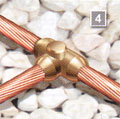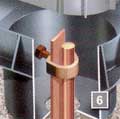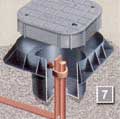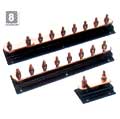| Earthing Lightning Protection | | Earthing design considerations |
|
|
|
How to apply earthing equipment |
|
The schematic above illustrates the key elements of an effective earthing system. | |
Earthing systems typically fall into (but are not limited to) one of the following categories:
| |
Conductors and Earth Rods As
with lightning protection, the first choice faced by the designer of an
earthing system is the type of conductor to be used. The correct choice
of conductor is extremely important, whether it be a simple below
ground electrode or a complex computer room signal reference grid. | |
Conductors Furse offer three types of conductor: Flat tape Solid circular and Stranded cable. A range of conductor materials are available. Above ground, copper, aluminium and steel may be used. Below ground, copper is the most common choice due to its high resistance to corrosion. It is important that earthing conductors should be correctly sized for their application, as they may be required to carry a considerable current for several seconds. For specific information on conductor ratings see Conductor Ratings.
| |
Earth Rods and Plates In addition to the conductors outlined above, earth rods and plates or any combination thereof can be used to achieve an effective earth depending on the site conditions. Earth rods take advantage of lower resistivity soils at greater depths than normal excavation will allow. Earth plates are used to attain an effective earth in shallow soils with underlying rocks or in locations with large amounts of buried services. They can also provide protection at potentially dangerous places eg HV switching positions.
|  |
Connectors and Terminations An effective earthing system relies on joints and connections to have good electrical conductivity with high mechanical strength. Poorly chosen or badly installed joints and connectors can compromise the safe operation of an earthing system. Furse offer a range of connectors and termination methods to suit a wide range of applications. | |
|
FurseWELD Exothermic Welding A simple, self-contained method of forming high quality electrical connections which requires no external power or heat source. Connections are made using the high temperature reaction of powdered copper oxide and aluminium. FurseWELD
connections allow conductors to carry higher currents than other types
of connections. They will never loosen, are highly conductive and have
excellent corrosion resistance. | 
|
|
For applications where exothermic welding is not appropriate for creating permanent connections, compression connectors may be used. Compression connectors produce very robust joints which can be buried in the ground or in concrete.
| 
|
Where permanent connections are not appropriate, mechanical clamps offer the ideal solution. These are typically used on smaller scale installations where periodic disconnection for testing is required. All Furse mechanical clamps are manufactured from high copper content alloy. They have high mechanical strength, excellent corrosion resistance and conductivity.
| 
|
Regular
inspection and testing of the earthing system is essential. Inspection
pits allow easy access to earth electrodes and conductors to facilitate
this procedure. | 
|
Earth
bars are an efficient and convenient way of providing a common earth
point. Integral disconnecting links mean the earth bars can be isolated
for testing purposes. | 
|
Soil Conditioning Agents Soil conditioning agents are to be used in areas where required resistivity levels are difficult to achieve. When used as a backfill for earth electrodes, soil conditioning agents effectively act to increase the electrodes surface area thus lowering its resistance to earth. |  |
| |
| |
